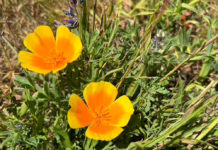After a rain, outdoor settings smell fresher, better. The word for that smell is “petrichor.” Scents are more easily detected on cool, moist days because water molecules capture scents and “hold” them for all to smell.
Morning dew aggregates scent molecules. That’s one reason why tracking dogs have their noses to the ground and perform better in the morning.
Tracking dogs like hounds have long ears which rustle up the leaves, raising the scent. Though human noses do not have as many receptors as most animals, it is estimated that humans can differentiate over 1 billion different smells. That estimate must be from an AI or mathematical study, rather than an in-person trial.
Unfortunately, an estimated 450 million people lost their sense of smell due to COVID-19. While it is estimated that 40% of those losing their olfactory sense will regain it in six months, many will not recover the delicious and not so delicious sensations. It’s reported that smell training can help correct this condition.
To date, WHO (World Health Organization) estimates 754 million people have had COVID and 6.8 million have died—approximately 1%. Unfortunately, it is still around.
Fun facts: Dogs have twice as many odor receptors as humans; cats are 14 times better at detecting odors than humans; a silk-worm moth can detect one molecule of scent seven miles away.
Science is focused on COVID’s affects on humans. But it is sobering to think how this disease might be affecting the natural world, where sense of smell dictates ways of life and reproduction.
COVID attacks olfactory support cells called sustentacular cells. Their role is to maintain a salt balance, promoting electrical connectivity that sends signals to the brain.
At first, it was feared COVID might be infecting olfactory neurons directly, the danger here being those neurons could lead the virus into the brain. Fortunately, those neurons do not have ACE2 receptors, and olfactory loss is due to chemical imbalances.
It will be interesting to understand in years to come how this pandemic has been experienced by the non-human partners on this Earth.









